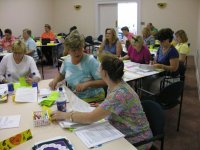Integration Strategies for PBL
Your content has been saved!
Go to My Saved Content.This series is about taking your PBL projects "up a notch." I wrote a blog about how to get started, but after you get started and are familiar with the benefits of keeping it small and focused, what are some of your next steps? One area where I see teachers taking their PBL projects up a notch is through integration. However, integration is actually quite complicated and includes many levels of implementation. Here are some tips to consider for integrating content areas into your next PBL project.
Know Your Level of Integration
When you plan your integrated PBL project, consider the following definitions and levels of integration articulated in Integrated Curriculum, an ASCD book edited by Heidi Hayes Jacob. When you examine these definitions, you'll realize there are many ways to integrate. Based on structures, you may be able to use only one of these approaches (because, for example, every classroom full of students is different and unique). Once you decide the level of integration, it will affect how many products students will create, and where and when content will be explored.
- Crossdisciplinary: Viewing one discipline from the perspective of another; for example, the physics of music and the history of math (Meeth 1978)
- Multidisciplinary: The juxtaposition of several disciplines focused on one problem with no direct attempt to integrate (Piaget 1972, Meeth 1978)
- Pluridisciplinary: The juxtaposition of disciplines assumed to be more or less related; e.g., math and physics, French and Latin (Piaget 1972)
- Transdisciplinary: Beyond the scope of the disciplines; that is, to start with a problem and bring to bear knowledge from the disciplines (Meeth 1978)
Know Content that Isn't Your Own
Teachers of the Blood Project at High Tech High really articulate this well. As you start to integrate more content, it forces you to look for connections in other content areas, which means that you must be familiar with those areas. This is important not only as you build and create your integrated PBL project, but also in the actual "doing" of the project. When I did a PBL project with my science and math teacher (I was teaching English at the time), students would come to me with questions that involved content in areas beyond my expertise. In order to best serve my students, I had to learn some of the content. When I did, not only could I be a better resource, but also my students trusted me. And this helped them trust that all teachers involved were well-prepared and could help them with any question or need they had.
It's Gotta Fit
This one is crucial. Oftentimes, we try to "fit a square peg in a round hole." We try to force integration when the content areas don't seem to match. I hear teachers say things such as, "Well, there could be math," or "We could try to find history that makes sense." This hesitancy is completely justified. It comes from the understanding that the connections are inauthentic or feel forced. When you meet with your team, look for connections that make sense and fit nicely. It may end up that one content area is targeting more standards than others, and that is fine. A good integrated PBL project doesn’t mean devoting an equal amount of time in each content area, but rather devoting time to connect content areas that align well.
Limit Products to Target ALL Content Standards
If you really want students to see the connections of the disciplines, then limit the amount of culminating products and performances that students are producing. While the multidisciplinary approach is a great way to implementation content integration, students may or may not see the nuances and connections across the content areas. This is because students are still creating products in "silos," or limiting their perspective to their own content areas. Once they create products that synthesize content areas, then they will be forced to examine how those areas connect.
Meet Frequently As a Team
It is so important to meet as a team, not just through the planning phase of a PBL project, but also as the project unfolds in the classroom. When I was implementing integrated PBL projects, our team met after school formally at least once a week. That doesn't include the frequent times I would literally run to another teacher's classroom to solve a problem or ask a question. Just as we encourage our students to revise and reflect throughout a PBL project, we as teachers should do the same. There must be a committed space for this to happen. Use this formal meeting time to see if new lessons are needed, address more student collaboration time, or uncover other issues that will come up.
How do you approach integration with your PBL projects? What examples do you have? What does it look like? Let's help each other build the best-integrated project -- and the most manageable project -- while we grow as teachers in our PBL expertise.
